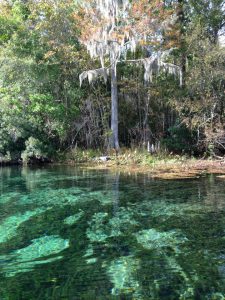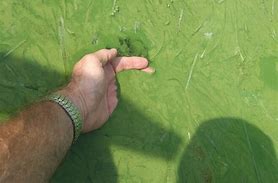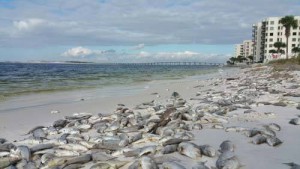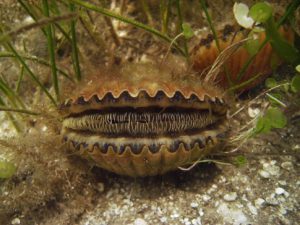Being in the panhandle of Florida you may, or may not, have heard about the water quality issues hindering the southern part of the state. Water discharged from Lake Okeechobee is full of nutrients. These nutrients are coming from agriculture, unmaintained septic tanks, and developed landscaping – among other things. The discharges that head east lead to the Indian River Lagoon and other Intracoastal Waterways. Those heading west, head towards the estuaries of Sarasota Bay and Charlotte Harbor.
Those heading east have created large algal blooms of blue-green algae (cyanobacteria). The blooms are so thick the water has become a slime green color and, in some locations, difficult to wade. Some of developed skin rashes from contacting this water. These algal blooms block needed sunlight for seagrasses, slow water movement, and in the evenings – decrease needed dissolved oxygen. When the algae die, they begin to decompose – thus lower the dissolved oxygen and triggering fish kills. It is a mess – both environmentally and economically.
On the west coast, there are red tides. These naturally occurring events happen most years in southwest Florida. They form offshore and vary in intensity from year to year. Some years beachcombers and fishermen barely notice them, other years it is difficult for people to walk the beaches. This year is one of the worst in recent memories. The increase in intensity is believed to be triggered by the increase in nutrient-filled waters being discharged towards their area.
On both coasts, the economic impact has been huge and the quality of life for local residents has diminished. Many are pointing the finger at the federal government who, through the Army Corp of Engineers, controls flow in the lake. Others are pointing the finger at shortsighted state government, who have not done enough to provide a reserve to discharge this water, not enforced nutrient loads being discharged by those entities mentioned above. Either way, it is a big problem that has been coming for some time.
As bad as all of this is, how does this impact us here in the Florida panhandle?
Though we are not seeing the impacts central and south Florida are currently experiencing, we are not without our nutrient discharge issues. Most of Florida’s world-class springs are in our part of the state. In recent years, the water within these springs have seen an increase in nutrients. This clouds the water, changing the ecology of these systems and has already affected glass bottom boat tours at some of the classic springs. There has also been a decline in water entering the springs due to excessive withdrawals from neighboring communities. The increase in nutrients are generally from the same sources as those affecting south Florida.

Florida’s springs are world famous. They attracted native Americans and settlers; as well as tourists and locals today.
Photo: Erik Lovestrand
Though we are not seeing large algal blooms in our local estuaries, there are some problems. St. Joe Bay has experienced some algal blooms, and a red tide event, in recent years that has forced the state to shorten the scallop season there – this obviously hurts the local economy. Due to stormwater runoff issues and septic tanks maintenance problems, health advisories are being issued due to high fecal bacteria loads in the water. Some locations in the Pensacola area have levels high enough that advisories must be issued 30% of the time they are sampled – some as often as 40%. Health advisories obviously keep tourists out of those waterways and hurt neighboring businesses as well as lower the quality of life for those living there.
Then of course, there is the Apalachicola River issue. Here, water that normally flows from Georgia into the river, and eventually to the bay, has been held back for water needs in Georgia. This has changed flow and salinity within the bay, which has altered the ecology of the system, and has negatively impacted one of the more successful seafood industries in the state. The entire community of Apalachicola has felt the impact from the decision to hold the water back. Though the impacts may not be as dramatic as those of our cousins in south Florida, we do have our problems.
What can we do about it?
The quick answer is reduce our nutrient input.
The state has adopted Best Management Practices (BMPs) for farmers and ranchers to help them reduce their impact on ground water and surface water contamination from their lands. Many panhandle farmers and ranchers are already implementing these BMPs and others can. We encourage them to participate. Read more at Florida’s Rangeland Agriculture and the Environment: A Natural Partnership – https://nwdistrict.ifas.ufl.edu/nat/2015/07/18/floridas-rangeland-agriculture-and-the-environment-a-natural-partnership/.
As development continues to increase across the state, and in the panhandle, sewage infrastructure is having trouble keeping up. This forces developments to use septic tanks. Many of these septic systems are placed in low-lying areas or in soils where they should not be. Others still are not being maintained property. All of this leads to septic leaks and nutrients entering local waterways. We would encourage local communities to work with new developments to be on municipal sewer lines, and the conversion of septic to sewer in as many existing septic systems as possible. Read more at Maintaining Your Septic Tank – https://nwdistrict.ifas.ufl.edu/nat/2017/04/29/maintain-your-septic-system-to-save-money-and-reduce-water-pollution/.
And then there are the lawns. We all enjoy nice looking lawns. However, many of the landscaping plans include designs that encourage plants that need to be watered and fertilized frequently as well as elevations that encourage runoff from our properties. Following the BMPs of the Florida Friendly Landscaping ProgramTM can help reduce the impact your lawn has on the nutrient loads of neighboring waterways. Read more at Florida Friendly Yards – https://nwdistrict.ifas.ufl.edu/nat/2018/06/08/restoring-the-health-of-pensacola-bay-what-can-you-do-to-help-a-florida-friendly-yard/.
For those who have boats, there is the Clean Boater Program. This program gives advice on how boaters can reduce their impacts on local waterways. Read more at Clean Boater – https://floridadep.gov/fco/cva/content/clean-boater-program.
One last snippet, those who live along the waterways themselves. There is a living shoreline program. The idea is return your shoreline to a more natural state (similar to the concept of Florida Friendly LandscapingTM). Doing so will reduce erosion of your property, enhance local fisheries, as well as reduce the amount of nutrients reaching the waterways from surrounding land. Installing a living shoreline will take some help from your local extension office. The state actually owns the land below the mean high tide line and, thus, you will need permission (a permit) to do so. Like the principals of a Florida Friendly Yard, there are specific plants you should use and they should be planted in a specific zone. Again, your county extension office can help with this. Read more at The Benefits of a Living Shoreline – https://nwdistrict.ifas.ufl.edu/nat/2017/10/06/the-benefits-of-a-living-shoreline/.
Though we may not be experiencing the dramatic problems that our friends in south Florida are currently experiencing, we do have our own problems here in the panhandle – and there is plenty we can do to keep the problems from getting worse. Please consider some of them. You can always contact your local county extension office for more information.
- Our Environment: Part 11 – We Need Water - July 7, 2025
- Our Environment: Part 10 – Improving Agriculture - June 20, 2025
- Marine Creatures of the Northern Gulf – Snails and Slugs - June 20, 2025



